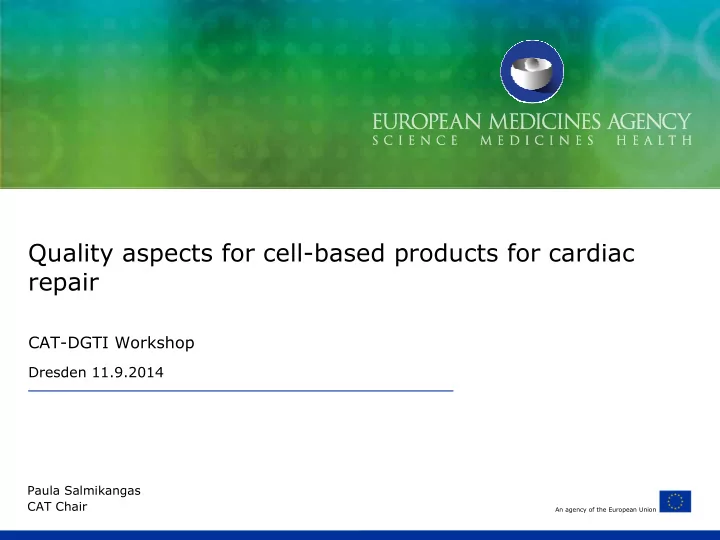

Quality aspects for cell-based products for cardiac repair CAT-DGTI Workshop Dresden 11.9.2014 Paula Salmikangas CAT Chair An agency of the European Union
Why quality matters? - Basic understanding of quality parameters always needed for research and commercial production, e.g. activity, impurities etc. - If the product is not characterised and its ´ quality not defined, non-clinical and clinical results may not be comparable and will be difficult to repeat efficacy signals are diluted failure of multisite clinical trials ? - Product target profile is required for clinical studies to ensure patient safety 1
cell based medicinal product DEFINITIONS AND QUALITY PRODUCT DEFINITION – qualified cell population (s) in the appropriate vehicle for the intended action PRODUCT CHARACTERISATION - Very relevant to ensure: • Consistency of the active substance / finished product • Validation of the manufacturing process • Comparability when manufacturing changes are introduced • Stability throughout shelve life • Release specifications selected from characterisation studies SPECIFIC REQUIREMENTS FOR CBMP : Directive 2009/120/EC + GL CBMP Identity – phenotypic profile - cell markers Purity and Viability – relevant population / populations in mixture / viable cell % Impurities – unwanted cells, reagents, adventitious agents, sterility, endo, mycoplasma Potency – quantitative measure of the biological activity – related to the intended action karyology, tumourigenicity, genetic stability – specially relevant for dividing differentiating cell populations 2 2 Margarida Menezes Ferreira - CAT Workshop for cell-based therapies for Cardiac Repair
Margarida Menezes Ferreira - CAT Workshop for cell-based therapies for Cardiac Repair
CARDIAC REPAIR CELL STRATEGIES heterogenious cell preparations FOR MI or CHF 1ST WAVE bone marrow aspirate - autologous Minimal manipulation - Separation / centrifugation Moderate results / no results 2ND WAVE MSC immuneselected / MPC - EPC Inconclusive Cell expansion Other sources – PBMC / adipocytes / placenta allogeneic Commited cells - Cardiomyocytes results ? 3RD WAVE ? Embryonic stem cells iPSC Margarida Menezes Ferreira - CAT Workshop for cell-based therapies for Cardiac Repair
Cell product definition Can conclusions be drawn from experience? Cardiomyocytes progenitor ? Endothelial progenitor ? Both ? Progenitor cells vs cardiomyocytes – differentiation stage ? Autologous vs allogeneic- Immunoregulatory properties ? Different Sources of progenitor cells – different clinical outcome? - Bone marrow – “ gold standard” ? - Adipocytes – Peripheral blood – cord blood – placenta ? - Characterisation beyond ISCT ? Margarida Menezes Ferreira - CAT Workshop for cell-based therapies for Cardiac Repair
CAT Expert meeting – quality aspects Non-manipulated (non-selected and selected) CBMPs derived from BM, apheresis Expanded CBMPs (MSCs, cardiac stem cells etc.) Questions posed to the experts: -identity: how different sources of the starting material impact on the intended action and, if from bone marrow non manipulated, should they be considered “homologous” use (the same function as in their origin)? - purity: to what extent it is known what type of cells are relevant and what cells can be deleterious for the indication considering also the sourcing of the substance? - potency - how to address potency in terms of functionality in relation 6 to the clinical indication and dose
Discussion on quality and manufacturing issues Cell origin, donation, separation: -Issues related to cell origin and donation (donor medication, age etc.) -Impact of the techniques used to retrieve cells (BMCs) -Difficulties in defining required therapeutic cell composition -number of stem cells in cell population is low increase of stem cells (GM-CSF) impact of mobilization on cell composition/quality?? -Cellular impurities and their impact on efficacy/safety? 7
Cell purity – possible to single out relevant and deleterious cell components ? How relevant the mixed population - How relevant engraftment vs paracrine How relevant cells vs targeted growth factor What cells can have deleterious effect - impurities Embryonic or iPS – lineage consistency – future possible ? Margarida Menezes Ferreira - CAT Workshop for cell-based therapies for Cardiac Repair
Manufacturing -Cell processing –manual vs. automatic -Impact of cell separation techniques on quality of the final product, choice of cell markers and antibodies/selection methods -Culture and differentiation of cells towards intended cell population (MSC-, cardiac-,…), how to demonstrate functionality and correct phenotype/genotype? -Reagents for manufacturing – quality and impact on cells (growth factors, cytokines etc.) -Product- and process-related impurities -How to manage variability? 9
Potency testing - Precise mechanism of MI? difficulties in defining the exact mode of action for cell-based products for MI - Potency testing should ideally follow MoA – sorted cells vs. BM/blood MNCs vs. cultured cells? - First claim that mononuclear cells or MSCs would form new cardiac tissue, later paracrine effects proposed. Markers/ function to follow for potency testing? Paracrine – what indicators ? - Cultured cardiomyocytes form new tissue – functionality? aligning to correct beating rythm or arythmia? - Persistence of cells and their migratory capacity? Engraftment – how to measure ? - Potency testing and link to efficacy 10
Administration and dose - Administration devices and their impact on cells (cell number and quality) - How to define the dose (cell number per volume or also other parameters/markers etc.) – conceivable to define dose / biological activity units instead of number of cells ? - Choice of excipients - Impact of storage on cell number and functionality? 11
General issues - Product standardisation in multisite production and trials? - Analytical techniques and their comparability across labs? - The underlying disease and patient condition to be considered, different healing capacities different treatment options for different indications (AMI, CHF,..)?? 12
Thank you for your attention! 13
Recommend
More recommend